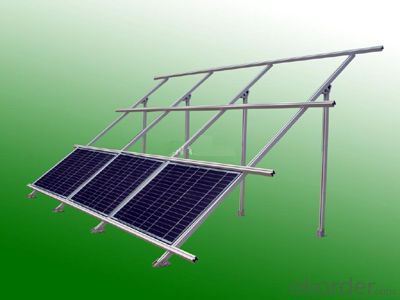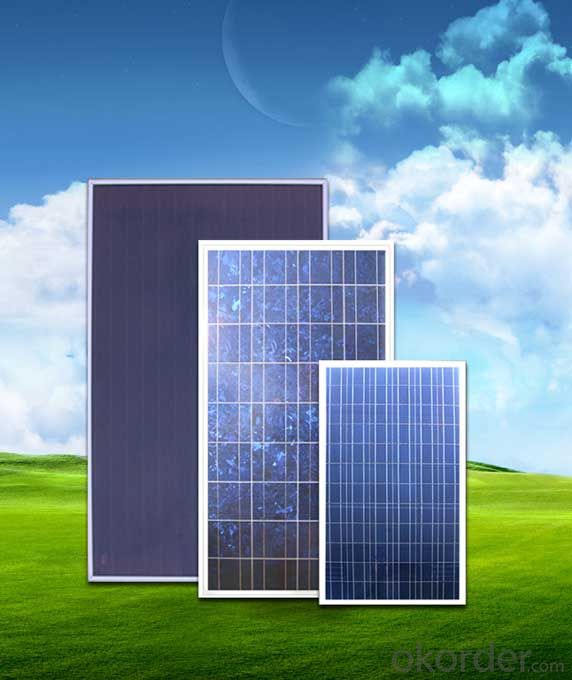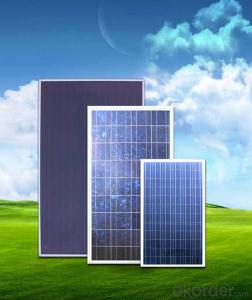Polycrystalline solar Panel with High Quality Best Price CNBM
- Loading Port:
- Qingdao
- Payment Terms:
- TT OR LC
- Min Order Qty:
- 10 set
- Supply Capability:
- 300000 set/month
OKorder Service Pledge
OKorder Financial Service
You Might Also Like
Polycrystalline Solar Modules
CNBM offers a range of small, medium and large polycrystalline solar modules, designed for a range of requirements.


Specifications:
Tolerance | +/-3% |
Cell | Polycrystalline silicon solar cells (156 x 156mm) |
N0. of Cells | 60 (0 x 6) |
Dimension of Modules (mm) | 1650 x 990 x 40 |
Weight (kg) | 25.5 |
Limits:
Operating Temperature | -40~+85? |
Storage Temperature | -40~+85? |
Maximum System Voltage | 1000 VDC max. |
Hail Impact | Diameter of 28mm with impact speed |
Temperature and Coefficients:
NOCT | 48C+/-2? |
Voltage temperature coefficient (%/K) | -0.35 |
Current temperature coefficient (%/K) | 0.05 |
Power temperature coefficient (%/K) | -0.45 |
Characteristics:
Model: | SGM-200P | SGM-210P | SGM-220P |
Max-power voltage Vmp (V) | 29.2 | 29.4 | 29.41 |
Max-power current Imp (A) | 6.85 | 7.14 | 7.48 |
Open-circuit voltage Voc (V) | 36.5 | 36.69 | 36.9 |
Short-Circuit Current Isc (A) | 7.28 | 7.6 | 7.93 |
Max-power Pm(W) | 200 | 210 | 220 |
Model: | SGM-230P |
Max-power voltage Vmp (V) | 29.8 |
Max-power current Imp (A) | 7.72 |
Open-circuit voltage Voc (V) | 37.31 |
Short-Circuit Current Isc (A) | 8.19 |
Max-power Pm(W) | 230 |
STC: Irradiance 1000W/m2, module temperature 25?, AM-=1.5
Poly Crystalline Solar Panels Specifications Range
Maximum Power (Pm) | Dimension | Weight | Operating Voltage (Vmp) | Operating Current (Imp) | Open Circuit Voltage (Voc) | Short Circuit Current (Isc) |
0.45W | 140x80x10mm | 0.08kg | 3.3V | 150mA | 4.6V | 160mA |
1.0W | 162x140x10mm | 0.16kg | 7.5V | 150mA | 10.3V | 160mA |
4.5W | 269x251x23mm | 0.8kg | 16.5V | 0.27A | 20.5V | 0.3A |
10W | 420.1×268.9×22.6mm | 1.92kg | 17.5V | 0.58A | 20.5V | 0.6A |
20W | 425x502x50mm | 3.0kg | 16.8V | 1.19A | 21.0V | 1.29A |
30W | 593x502x22.6mm | 3.9kg | 16.8V | 1.78A | 21.0V | 1.94A |
40W | 655x537x50mm | 5.75kg | 17.3V | 2.31A | 22.1V | 2.54A |
50W | 839x537x50mm | 6.0kg | 17.5V | 2.9A | 21.8V | 3.17A |
65W | 1111x502x50mm | 7.2kg | 17.6V | 3.69A | 22.1V | 3.99A |
80W | 1204x537x50mm | 7.7kg | 17.6V | 4.55A | 22.1V | 4.8A |
- Q:How do solar cells handle voltage fluctuations?
- Solar cells do not handle voltage fluctuations directly. However, to manage voltage fluctuations, additional components such as voltage regulators or inverters are used in conjunction with solar cells. These components help stabilize and regulate the voltage output from solar cells to ensure consistent and reliable power supply.
- Q:What is the solar cell production process
- Scientists in order to reduce the cost of solar cell manufacturing, along the two paths: one is the development of new solar cell materials, the other path is to improve the efficiency of solar cell conversion.
- Q:Can solar cells be used to power electronic devices?
- Yes, solar cells can be used to power electronic devices. Solar cells convert sunlight into electricity, which can then be used to power various electronic devices such as calculators, smartphones, and even larger appliances like laptops or refrigerators when appropriately connected to the solar cell system.
- Q:Can solar cells be used for powering schools?
- Yes, solar cells can be used to power schools. Solar energy is a renewable and sustainable source of power, and installing solar panels on school rooftops or grounds can generate electricity to meet the energy needs of schools. This can significantly reduce the reliance on fossil fuels and decrease carbon emissions, making it an environmentally friendly solution. Additionally, solar power can provide a reliable and consistent energy source, especially in sunny regions, ensuring schools have a stable power supply.
- Q:How do solar cells impact the local economy?
- Solar cells have a positive impact on the local economy as they create jobs, stimulate investment, and reduce energy costs. The installation, maintenance, and manufacturing of solar cells require skilled labor, thus creating employment opportunities within the community. Additionally, the growth of the solar industry attracts investments in infrastructure and research, fostering economic development. Moreover, solar energy helps lower electricity bills for businesses and households, freeing up funds that can be spent on other local goods and services, thereby boosting economic activity.
- Q:What is the environmental impact of solar cells?
- Solar cells have a relatively low environmental impact compared to other forms of energy generation. While their production does require the extraction and processing of raw materials, such as silicon and metals, the overall energy and resource requirements are relatively low. Furthermore, solar cells generate electricity without emitting greenhouse gases or other pollutants during operation, reducing air and water pollution. Although their end-of-life disposal can pose some environmental challenges, proper recycling and waste management can minimize these impacts. Overall, the environmental benefits of solar cells, including reduced carbon emissions and resource conservation, outweigh their limited environmental footprint.
- Q:What is a good introduction of solar cell?
- In my opinion, a simple and interesting experiment would be a good start.
- Q:Can solar cells be used to power water purification systems?
- Yes, solar cells can be used to power water purification systems. Solar cells convert sunlight into electricity, which can then be used to power various devices, including water purification systems. This allows for a sustainable and environmentally-friendly solution to provide clean and safe drinking water in areas without access to electricity grids.
- Q:Is the Photovoltaic Cells cheap to buy?
- Photovoltaic Cells is cheaper than some kinds of solar cells because of the material that made of the Photovoltaic Cells is low cost one.
- Q:How do solar cells perform in areas with high levels of water pollution?
- Solar cells may be adversely affected in areas with high levels of water pollution. The presence of pollutants, such as chemicals or particles, in the water can reduce the amount of sunlight reaching the solar cells, thereby decreasing their efficiency. Additionally, water pollution can lead to the accumulation of dirt, debris, or algae on the surface of the solar panels, further diminishing their performance. Regular cleaning and maintenance are essential in such areas to ensure optimal functioning of solar cells.
1. Manufacturer Overview |
|
|---|---|
| Location | |
| Year Established | |
| Annual Output Value | |
| Main Markets | |
| Company Certifications | |
2. Manufacturer Certificates |
|
|---|---|
| a) Certification Name | |
| Range | |
| Reference | |
| Validity Period | |
3. Manufacturer Capability |
|
|---|---|
| a)Trade Capacity | |
| Nearest Port | |
| Export Percentage | |
| No.of Employees in Trade Department | |
| Language Spoken: | |
| b)Factory Information | |
| Factory Size: | |
| No. of Production Lines | |
| Contract Manufacturing | |
| Product Price Range | |
Send your message to us
Polycrystalline solar Panel with High Quality Best Price CNBM
- Loading Port:
- Qingdao
- Payment Terms:
- TT OR LC
- Min Order Qty:
- 10 set
- Supply Capability:
- 300000 set/month
OKorder Service Pledge
OKorder Financial Service
Similar products
New products
Hot products
Related keywords


























